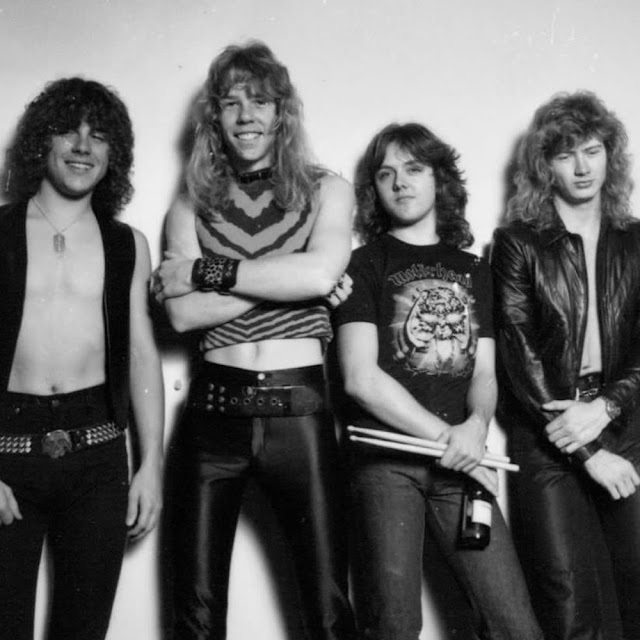Metallica was formed in Los Angeles in late 1981 when Danish drummer Lars Ulrich placed an advertisement in a Los Angeles newspaper, The Recycler, which read, “Drummer looking for other metal musicians to jam with Tygers of Pan Tang, Diamond Head and Iron Maiden.” Guitarists James Hetfield and Hugh Tanner of Leather Charm answered the advertisement. Although he had not formed a band, Ulrich asked Metal Blade Records founder Brian Slagel if he could record a song for the label’s upcoming compilation album, Metal Massacre. Slagel accepted, and Ulrich recruited Hetfield to sing and play rhythm guitar. The band was officially formed on October 28, 1981, five months after Ulrich and Hetfield first met.
The band name came from Ulrich’s friend Ron Quintana, who was brainstorming names for a fanzine and was considering MetalMania or Metallica. After hearing the two names, Ulrich wanted the latter for his band, so he suggested Quintana use MetalMania instead. Dave Mustaine replied to an advertisement for a lead guitarist; Ulrich and Hetfield recruited him after seeing his expensive guitar equipment. In early 1982, Metallica recorded its first original song, “Hit the Lights,” for the Metal Massacre I compilation. Hetfield sang and played both bass and rhythm guitar, while Lars Ulrich played drums and Lloyd Grant was credited with a guitar solo. Metal Massacre I was released on June 14, 1982; early pressings listed the band incorrectly as “Mettallica,” angering the band. The song generated word of mouth, and the band played its first live performance on March 14, 1982, at Radio City in Anaheim, California, with newly recruited bassist Ron McGovney. Their first live success came early; they were chosen to open for British heavy metal band Saxon at one gig of their 1982 U.S. tour. This was Metallica’s second gig. Metallica recorded its first demo, Power Metal, whose name was inspired by Quintana’s early business cards, in early 1982.
In late 1982, Ulrich and Hetfield attended a show at the West Hollywood nightclub Whisky a Go Go, which featured bassist Cliff Burton in the band Trauma. The two were “blown away” by Burton’s use of a wah-wah pedal and asked him to join Metallica. Hetfield and Mustaine wanted McGovney to leave because they thought he “didn’t contribute anything, he just followed.” Although Burton initially declined the offer, by the end of the year, he had accepted on the condition that the band move to El Cerrito in the San Francisco Bay Area. Metallica’s first live performance with Burton was at the nightclub The Stone in March 1983, and the first recording to feature Burton was the Megaforce demo (1983).
Metallica was ready to record their debut album, but when Metal Blade was unable to cover the cost, they began looking for other options. Concert promoter Jonathan “Jonny Z” Zazula, who had heard the demo No Life ’til Leather (1982), offered to broker a record deal between Metallica and New York City–based record labels. After those record labels showed no interest, Zazula borrowed enough money to cover the recording budget and signed Metallica to his own label, Megaforce Records.
In May 1983, Metallica traveled to Rochester, New York, to record its debut album, Metal Up Your Ass, which was produced by Paul Curcio. The other members decided to eject Mustaine from the band because of his drug and alcohol abuse and violent behavior just before the recording sessions on April 11, 1983. Exodus guitarist Kirk Hammett replaced Mustaine the same afternoon. Metallica’s first live performance with Hammett was on April 16, 1983, at a nightclub in Dover, New Jersey, called The Showplace; the support act was Anthrax’s original lineup, which included Dan Lilker and Neil Turbin. This was the first time the two bands performed live together.
Because of conflicts with its record label and the distributors’ refusal to release an album titled Metal Up Your Ass, the album was renamed Kill ’Em All. It was released on Megaforce Records in the U.S. and on Music for Nations in Europe, and peaked at number 155 on the Billboard 200 in 1986. Although the album was not initially a financial success, it earned Metallica a growing fan base in the underground metal scene.
Here, below is a collection of 40 amazing photographs of Metallica from their early days from the early 1980s:
















































0 comments:
Post a Comment